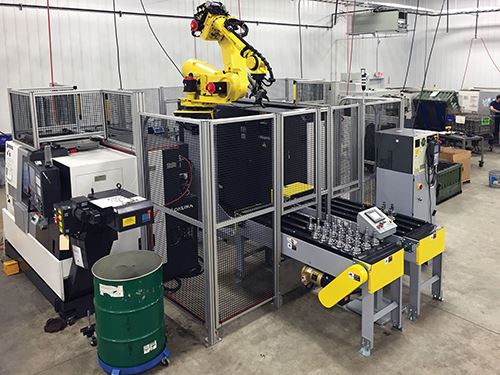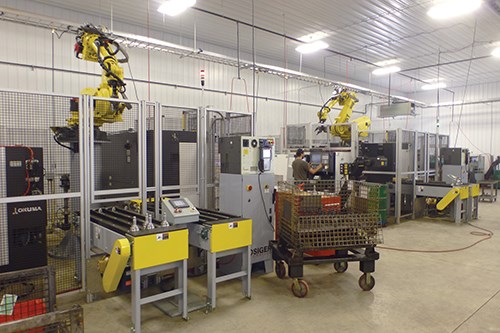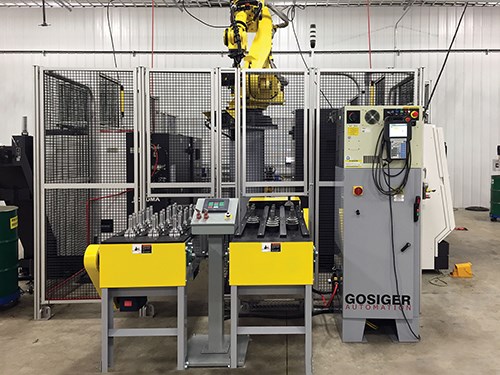Turning a Profit with Automation
CL Tech could not profitably meet increased production demand until it added robotic automation. The move saved money in operating costs and eliminated the need for peripheral devices.
Share


.png;maxWidth=45)
DMG MORI - Cincinnati
Featured Content
View More

Takumi USA
Featured Content
View More



Autodesk, Inc.
Featured Content
View MoreManually loading machines was not a profitable option for CL Tech, a central Indiana-based CNC job shop that needed to be able to produce 40,000 constant-velocity (CV) joints per month to land a contract with a major automotive supplier. After careful consideration, the company decided to incorporate robotic automation from Gosiger Automation (Dayton, Ohio) into its production process, saving thousands of dollars in operating costs.
During the past four years, CL Tech has grown from a $1 million tool and die company to a $5 million production facility. Along with its two sister companies, M A Metal (which does metal stamping, fabrication, laser cutting and tube-forming work) and HTD Machining Co. Inc. (which offers CNC machining, EDM, grinding and more), growth has been accompanied by continuously improving processes to reduce costs and increase productivity.
In the case of the CV joint order from an existing customer, CL Tech needed to figure out how to meet the demand for high-volume part turning with 100-percent inspection of critical dimensions.
“We considered the entire process—receiving the raw forging, turning to a rough finish on the stem end, finishing the cup end, performing 100-percent inspection on several dimensions, and conveying the part to the next operation,” says Jim Krohn, vice president.
After analyzing the traditional approach of manually loading the machine tools in terms of throughput, manpower requirements and how to perform the required part inspection, the company quickly recognized the need to automate some of the processes to reduce overall cost and production time.
CL Tech evaluated three possible automation solutions and chose the one proposed by Gosiger based on the following five criteria:
- Cycle time requirements met or exceeded.
- Adequate technical service and support capabilities, including past service performance, spare parts availability, installation and warranty.
- Compatibility with existing equipment, including familiarity of controls and quality
of training. - Resale market value and financing terms.
- Cost.
“We use a number of Okuma machine tools, and we’ve had a relationship with Gosiger for many years. They’ve always worked well as a partner with us, so we were comfortable that they could successfully implement the automation solution they proposed,” Mr. Krohn says.
The system Gosiger Automation designed for CL Tech employs a FANUC R-2000iB/165R six-axis, pedestal-mounted robot placed behind two Okuma lathes. The first lathe—a four-axis LU-3000EX—ID-chucks the part on the forged ID form of its bell-mouthed end and uses the tailstock with an extended quill stroke to end-register and support the part. The second lathe—an LB-3000EX—OD-chucks the part on the shaft using a shoulder for end registration. A tailstock seats the part to overcome an internal, chuck-mounted, spring-loaded center.
The FANUC robot’s dual-gripper, end-of-arm-tooling loads and unloads parts for both lathes. It employs vision for radial part orientation and wrist rotation to turn parts around between operations, which eliminates the need for more peripheral devices that would require additional setup, adjustment, maintenance, tooling and controls. The robot arm is positioned above and behind the lathes to enable workers to safely use the machine controls for monitoring and adjusting without entering the robot’s work area.
In operation, workers manually stand about 40 rough workpieces on end, in random radial orientation, on a steel, flat-top, incoming conveyor. The robot picks up the part, then uses its vision camera to determine the workpiece orientation and load the part into the first lathe.
Both lathes are loaded through pneumatic top hatches that save time by eliminating the need to open and close the machine doors. The Gosiger-built hatches are designed to operate smoothly using linear guideway bearings and are actuated by rod-less pneumatic cylinders.
At the end of the first machining operation, the robot arm picks up the workpiece and places it in an automatic, post-process inspection gage that feeds tool offset data to the first machine tool. The robot then loads the workpiece into the second lathe for the next machining process. A unique characteristic of the automation design is that there is no need for either a re-gripping station or a special mechanism to rotate the part end-for-end between operations, as this is accomplished by the robot’s fourth axis.
For the second operation in which the robot loads the machine chuck, the part is positively seated by a re-chucking sequence that uses a parts pusher to overcome the spindle-mounted, spring-loaded part center. To maximize cell throughput, there is a 15-part, mid-process work queue between the automatic gage and the second lathe.
According to CL Tech, the turnkey automation system eliminates manual labor equivalent to 10 employees, thus saving about $500,000 per year. At the same time, existing machine operators increased their technical skills to earn higher wages. The automatic gaging system provides 100-percent inspection, as required by the customer, and feeds data back to the lathes to maintain consistent product quality. Automating this process enabled the company to reduce its capital expense compared to a manual system, which would have required an additional lathe to meet the monthly parts-production quota.
Another benefit of the Gosiger Automation design is the ability to easily make changes, Mr. Krohn says. This came in handy when the company was getting ready to start production and its customer modified the part. The only change CL Tech needed to make to accommodate this change was to the robot gripper.
“What I like best about working with Gosiger is that they listened to our needs, came up with a unique solution, and followed through with the right kind of support,” Mr. Krohn says.
Related Content
Cutting Part Programming Times Through AI
CAM Assist cuts repetition from part programming — early users say it cuts tribal knowledge and could be a useful tool for training new programmers.
Read MoreInside the Premium Machine Shop Making Fasteners
AMPG can’t help but take risks — its management doesn’t know how to run machines. But these risks have enabled it to become a runaway success in its market.
Read MoreFour-Axis Horizontal Machining Doubles Shop’s Productivity
Horizontal four-axis machining enabled McKenzie CNC to cut operations and cycle times for its high-mix, high-repeat work — more than doubling its throughput.
Read MoreUsing the Toolchanger to Automate Production
Taking advantage of a feature that’s already on the machine tool, Lang’s Haubex system uses the toolchanger to move and store parts, making it an easy-to-use and cost-effective automation solution.
Read MoreRead Next
Registration Now Open for the Precision Machining Technology Show (PMTS) 2025
The precision machining industry’s premier event returns to Cleveland, OH, April 1-3.
Read MoreSetting Up the Building Blocks for a Digital Factory
Woodward Inc. spent over a year developing an API to connect machines to its digital factory. Caron Engineering’s MiConnect has cut most of this process while also granting the shop greater access to machine information.
Read More5 Rules of Thumb for Buying CNC Machine Tools
Use these tips to carefully plan your machine tool purchases and to avoid regretting your decision later.
Read More



















































